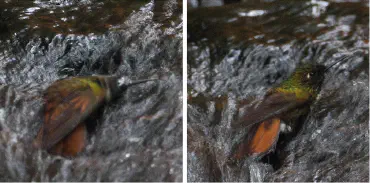A novel mode of bathing behavior of hummingbirds recorded in the Brazilian ruby Heliodoxa rubricauda and allies (Aves: Trochilidae)
 Brazilian Ruby Heliodoxa rubricauda bathing in a waterfall. Photo: F. Schunck
Brazilian Ruby Heliodoxa rubricauda bathing in a waterfall. Photo: F. SchunckAbstract
The Brazilian ruby, Heliodoxa rubricauda, is a forest species of hummingbird endemic to the Atlantic Forest. It belongs to an Andean clade of birds with robust and strong legs and adapted to feed on inflorescences of plants from high regions and influenced by strong winds. It occurs from northeastern to southern Brazil on slopes, sierras, and mountains and has the little-known behavior of bathing in waterfalls and forest streams. Based on five field observations made in the state of São Paulo, and records available from online photo platforms, we concluded that H. rubricauda is the only species of hummingbird in Brazil that bathes by settling on rocks of forest waterfalls with medium to strong currents. This behavior is made possible by the robust and strong legs the species inherited from its evolutionary lineage, which, in the Atlantic Forest, are used for feeding, defense, and bathing. We hypothesize that this behavior is more efficient for body hygiene than other existing behaviors because it allows a greater amount of water to pass over the body, thereby eliminating traces of food and parasites, in addition to reducing risks of predation.